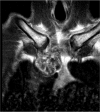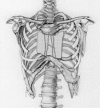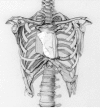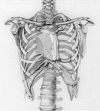Stable construction of the sternum after broad radical resection of malignant tumours
- PMID: 24964463
- PMCID: PMC3813797
- DOI: 10.1093/jscr/rjt049
Stable construction of the sternum after broad radical resection of malignant tumours
Abstract
Radical resection of primary or solitary secondary malignant sternal tumours is indicated in patients without metastases. Sternal reconstruction may be indicated in large defects to prevent pulmonary complications, to achieve protection of intra-thoracic organs and to obtain a good aesthetic result. In this article, a modified surgical technique is described to fill and reconstruct large defects after radical resection of a primary or secondary malignant sternal tumour. The technique makes use of a methyl methacrylate composite within two layers of polypropylene mesh enforced by steel wires through the sternal ends of the defect enhancing stability. This modified technique can be easily applied, making curative broad radical resections of the sternum feasible.
Published by Oxford University Press and JSCR Publishing Ltd. All rights reserved. © The Author 2013.
Figures








References
-
- Warzelhan J, Stoelben E, Imdahl A, Hasse J. Results in surgery for primary and metastatic chest wall tumours. Eur J Cardiothorac Surg. 2001;19:584–8. doi:10.1016/S1010-7940(01)00638-8. - DOI - PubMed
-
- Lequaglie C, Massone PB, Giudice G, Conti B. Gold standard for sternectomies and plastic reconstructions after resections for primary or secondary sternal neoplasms. Ann Surg Oncol. 2002;9:472–9. doi:10.1245/aso.2002.9.5.472. - DOI - PubMed
-
- Incarbone M, Nava M, Lequaglie C, Ravasi G, Pastorino U. Sternal resection for primary or secondary tumours. J Thorac Cardiovasc Surg. 1997;114:93–9. doi:10.1016/S0022-5223(97)70121-1. - DOI - PubMed
-
- Pairoleo PC, Arnold PG. Thoracic wall defects: surgical management of 205 consecutive patients. Mayo Clin Proc. 1986;61:557–63. doi:10.1016/S0025-6196(12)62004-7. - DOI - PubMed
-
- Weyant MJ, Bains MS, Venkatraman E, Downey RJ, Park BJ, Flores RM, et al. Results of chest wall resection and reconstruction with and without rigid prosthesis. Ann Thorac Surg. 2006;81:279–85. doi:10.1016/j.athoracsur.2005.07.001. - DOI - PubMed
LinkOut - more resources
Full Text Sources
Other Literature Sources

